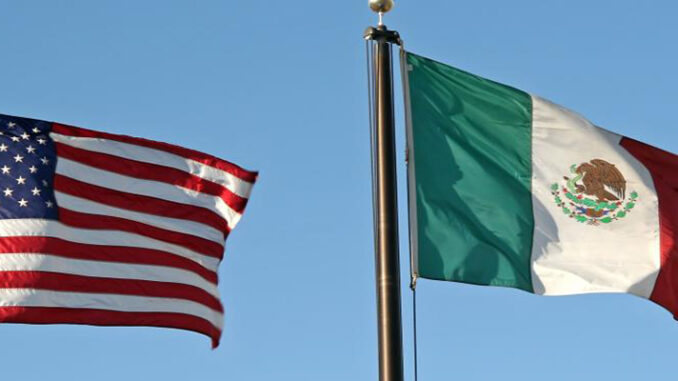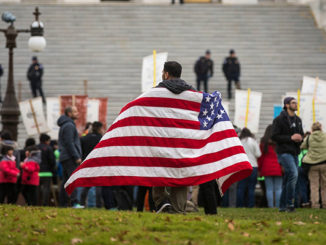
While each country has unilateral improvements to make within their own borders to address the current conditions, there is an urgent need for collaboration.
by Senator Claudia Ruiz-Massieu and U.S. Rep Henry Cuellar
As history has shown, time and time again, it is human nature to seek a better life, particularly in the face of suffering and hardship. For both the U.S. and Mexico, the clearest example of this dilemma is present along the 2,000-mile-long border shared between the two countries. Legal residents and citizens often live in neighborhoods with no running water or basic infrastructure. Many small business owners are struggling to make ends meet. We must find a way to balance the needs of those already in our country, while also offering refuge and support to those fleeing persecution and seeking better opportunities. This applies not just to the U.S., but also to Mexico.
Since October 2020, United States Customs and Border Protection (CBP) has encountered more than 1.7 million individuals trying to enter the United States disregarding the law, a 20-year high. Of this total, 1.5 million individuals were encountered along the southern border with Mexico. The graphic in this BBC story illustrates these migration patterns clearly: a steady decline from 2004 to 2011, then things remain relatively stable until a dramatic rise in 2019. While the COVID-19 pandemic affected migration—effectively forcing people to remain in place in the first half of 2020 due to the public health emergency—the second half saw migration quickly rebound to the record levels we see today.
As the United States and Mexico look toward innovative solutions to resolve the push and pull factors of migration at our shared borders and across the region, the two countries must work together to address the immediate challenges that border communities—on both sides—face.
A SHIFTING ROLE FOR MEXICO
Though historically a country of emigrants, recent figures show that Mexico has also become a transit country for migrants. Since the mid-2000s, individuals from the Northern Triangle countries of Honduras, Guatemala and El Salvador have migrated in droves, surpassing the total number of Mexican migrants. In 2010, it was estimated that more than 128,000 irregular migrants passed through Mexico to reach the United States. By 2017, that figure jumped to 296,829, and reached an all-time high in 2020 to more than 300,000 people. Furthermore, the latest numbers indicate that of the 16,400 people in U.S. Border Patrol custody nationwide, more than 12,000 are from countries other than Mexico.
For the U.S., this requires a robust border security system—one that allows for efficient processing of migrants while border patrol continues to enforce the laws. There is an urgent need for increased staffing combined with improved technology and additional immigration judges to decrease the growing backlog of pending cases.
Mexico is not just a country of transit, but rather has become a country of destination for migrants. In 2010, it was estimated 969,271 people born abroad, but living in Mexico, were residents of the country. By 2017, this number had increased to 1,007,063 and reached 1.2 million in 2020.
Therefore, Mexico must also adapt its migration system to address these new realities. The actions taken by the current government in the face of an increasing flow of migrants from Central America, particularly those involving the use of force by the National Guard, must be reconsidered to protect human rights and dignity. The institutions that are currently involved with the country’s migration policy, including the Ministry of the Interior, the Ministry of Foreign Affairs, and the National Guard, reflect the gaps and overlaps that define Mexico’s unclear institutional framework put in place. The federal government and local authorities would benefit from a clearer division of work among the relevant agencies to enact a coherent and coordinated strategy to adapt and tackle the needs arising from emerging trends.
AN URGENT NEED FOR COOPERATION
While each country has unilateral improvements to make within their own borders to address the current conditions, there is an urgent need for collaboration. A strong history of bilateral relations between Mexico and the United States, particularly relating to migration, provides opportunities for both learning and improvement.
In the early 2000s, under the Peña Nieto and Obama administrations, the principles of co-responsibility and co-management served as the foundation for bilateral cooperation around migration. Utilizing a multilayered approach, the two governments collaborated to create the Repatriation Strategy and Policy Executive Coordination Team (RESPECT), conceived as a decision-making body to guarantee secure and orderly deportations, and establishment of the Border Violence Prevention Council, a bilateral effort to emphasize preemptive protection to reduce violent incidents at the U.S.-Mexico border. Bilateral coordination during this time was largely limited to issues directly related to the U.S.-Mexico border, creating guidelines to regulate border patrol activities, and boosting border infrastructure within the framework of a smart border partnership.
The election of Donald Trump ushered in a period where migration was no longer viewed as a natural phenomenon, but something that needed to be controlled. Policies heavily favored unilateral decision making over binational collaboration, perhaps as best demonstrated by the construction of a border wall between Mexico and the United States as the signature strategy to tackle irregular migrant flows. The Peña Nieto administration, on the other hand, turned to an ambitious consular protection scheme and other multilateral operations in an effort to establish guidelines to make migration a safe, orderly, and regular phenomenon through the Global Compact of Migration.
The bilateral approach to migration experienced a significant shift after Andrés Manuel López Obrador’s election as president of Mexico in 2018. Unlike during the previous government, Donald Trump did engage in migration negotiations with Mexico under the López Obrador’s administration. Despite this, a clear divide emerged between the two countries, both in terms of a shared vision and active collaboration regarding migration. The threat of tariffs on Mexican exports drove the 2019 U.S.-Mexico Agreement, under which Mexico committed to deploying the National Guard to contain increasing flows of migrants coming from Central America through Mexico’s southern border. During this time, the Trump administration implemented the Migration Protection Protocols (MPP), also known as the Remain in Mexico policy for its controversial requirement that land-crossing asylum seekers remain in Mexico while awaiting their asylum hearings in the U.S. This policy forces asylum seekers, who have traveled hundreds of miles, often through precarious conditions, and who are already extremely vulnerable, to wait in dangerous, unsanitary, and unsafe situations where they are at the vulnerability of cartels and other predators. Despite the Biden Administration’s attempts to dismantle this policy, the Supreme Court’s decision to reinstate MPP in August 2021 means that the use of MPP will continue, with recent reports saying the policy will restart as soon as November 2021.
Despite the challenges of previous administrations, the United States and Mexico are faced with a unique opportunity to reform and shape migration policy and must do so by working to reestablish a collaborative structure that can more easily adapt to the new migration realities.
DEVELOPING A REGIONAL LAW ENFORCEMENT COOPERATION
Border security strategies are being developed to deter and stop illegal migrations before individuals arrive at the U.S.-Mexico border. Law enforcement cooperation between the United States, Mexico, and Central America serves as the starting point for these efforts. For example, the Mérida Initiative—which is now at a crossroads—improved security cooperation between Mexico and the United States to address threats, strengthen the rule of law, and build resilient communities in both countries. The partner countries could sign a new agreement that links to the Central America Regional Security Initiative, which provides funding and training to Central American law enforcement agencies to promote public safety in the region. Alternatively, the United States and Mexico can incorporate El Salvador, Guatemala, and Honduras into a new security agreement.
The United States and Mexico could also encourage Canada to pursue regional security cooperation that provides Mexican federal authorities with the resources to tackle security issues at the Mexico-Guatemala border as a contributor to Canada’s national security. One model for this effort is the 2011 U.S.-Canada Beyond the Border Initiative, which saw the two countries establish new programs and protocols to strengthen joint security cooperation at their shared border.
Finally, the scope of regional law enforcement activities should include security and non-security issues. For instance: professionalizing immigration agencies in Mexico and the Northern Triangle countries; improving the coordination of asylum processing in the region; and working with the Northern Triangle countries to improve their immigration enforcement efforts between ports of entry, especially for extracontinental migrants who do not have freedom of movement in the region.
Regardless of the vehicle for promoting cooperation in the region to uphold the law, this effort will require the open sharing of information, so the countries should select agreed-upon vetting mechanisms to screen law enforcement partners.
A MORE EFFICIENT TEMPORARY FOREIGN WORKER PROGRAM
However, our efforts cannot solely focus on preventing irregular migration. We need to encourage legal migration. One step toward that would be improvement in the temporary foreign worker program. Temporary worker visas help U.S. employers fill open jobs with qualified workers when they cannot find Americans for the positions. These programs could use small adjustments to maximize their benefit to the American economy. This would also allow more Mexicans to enter the U.S. legally and the same for Central Americans, lessening the burden of those detained in Mexico at the border.
The H-1B visa program allows U.S. companies to temporarily employ highly skilled immigrants. The H-2B visa program is for foreign workers seeking employment in nonagricultural jobs, while the H-2A visa program is for seasonal agricultural workers. The U.S. Congress should tie visas to employees, making them portable between jobs. The employers currently control the visa, meaning a worker cannot easily change jobs without being granted a new visa. This opens the possibility of abuse by employers and creates inefficiencies for the economy. Employees should be granted the visa, allowing wage levels to signal where the most pressing labor needs exist. For visas with statutory caps, like the H-1B and H-2B, Congress should either raise the caps significantly or create caps that are market-driven. These two programs are woefully inadequate to meet the needs of the U.S. economy, leaving employers — many small businesses — without the labor needed to successfully operate and grow our regional economy.
Each of these visa programs should have a workable adjustment of status provision to allow the visa holder to apply for a green card. Currently, only the H-1B program allows visa holders to eventually apply for a green card. No such provision exists for the H-2A and H-2B programs. Letting these visa holders adjust their status to permanent residency would allow us to retain their economic contributions over the long term. Without adjustment of status, or a realistic opportunity to obtain a green card in a few years, the United States is in a weakened position relative to its competitor nations. The U.S. will lose talent as workers decide to seek their immigration fortunes elsewhere.
THE ROOT CAUSES OF IRREGULAR MIGRATION
There is also a significant need to address the root causes of irregular migration, beyond Mexico, specifically, in the Northern Triangle, from where most irregular migrants originate. Several Central American countries—particularly El Salvador, Guatemala, and Honduras—are struggling with widespread insecurity, fragile political and judicial systems, and high levels of poverty and unemployment. The inability of Central American governments to address these challenges effectively has far-reaching implications for the U.S.-Mexico border.
While socioeconomic reforms in the 1980s and 90s raised economic output, living conditions for many Central Americans were not improved, largely in part due to weakened government institutions and the presence of corruption. Violence in Central America has increased rapidly in the 21st century, putting further strain on public institutions. International criminal organizations, like drug cartels and human traffickers, smuggle contraband and participate in criminal trafficking, added to an unstable and unsafe environment. Moreover, natural disasters over the years, such as storms, droughts, plant diseases, and earthquakes have affected local agricultural production, negatively impacting job creation and employment rates. These issues are likely to become even more profound as the consequences of climate change become increasingly apparent. These climate and organizational challenges often take decades to rectify, resulting in the circular migration patterns.
Neither Mexico nor the United States can manage migration in a safe, orderly, and regular manner if violence, poverty, and climate disasters, continue to drive millions of people in Central America to leave their countries in search of a better life. To combat these challenges, we must focus our efforts on making the region a safer and more hospitable place. We must promote an economically prosperous, lawfully secure, and well-governed Central America. We must provide adequate foreign assistance to help promote prosperity, improve security, and strengthen governance. In short, U.S.-Mexico bilateral cooperation requires an expanded scope and reach to include broader development strategies.
The Path Forward
As we look towards the future, we must acknowledge that border security and mass migration is a long-term issue that requires both consistent and anticipatory thinking and planning. The situation requires a delicate balance between addressing migration incentives with humanitarian challenges across the world. Together, the United States must strengthen relationships with Mexico and the Northern Triangle countries of Central America to promote security, economic opportunity, and safety throughout the entire region.
We have before us an unparalleled opportunity. The political landscape in Washington favors those visions that do not only consider the legitimate security concerns, but also the human rights and economic needs that give rise to this phenomenon. More than ever, our governments should work not to close borders and limit migration, but to make significant efforts to increase safe and secure migration flows. We have the potential to demonstrate that the balance between the need for greater mobility and security is an attainable goal that can work to benefit both nations.
We must embrace this new era of cooperation and shared responsibility across the Rio Grande and move on to a robust and comprehensive bilateral strategy that benefits both countries, our citizens, and the region as a whole.
U.S. Congressman Henry Cuellar represents the 28th District of Texas. Senator Claudia Ruiz-Massieu is the former Foreign Affairs Secretary of Mexico.



